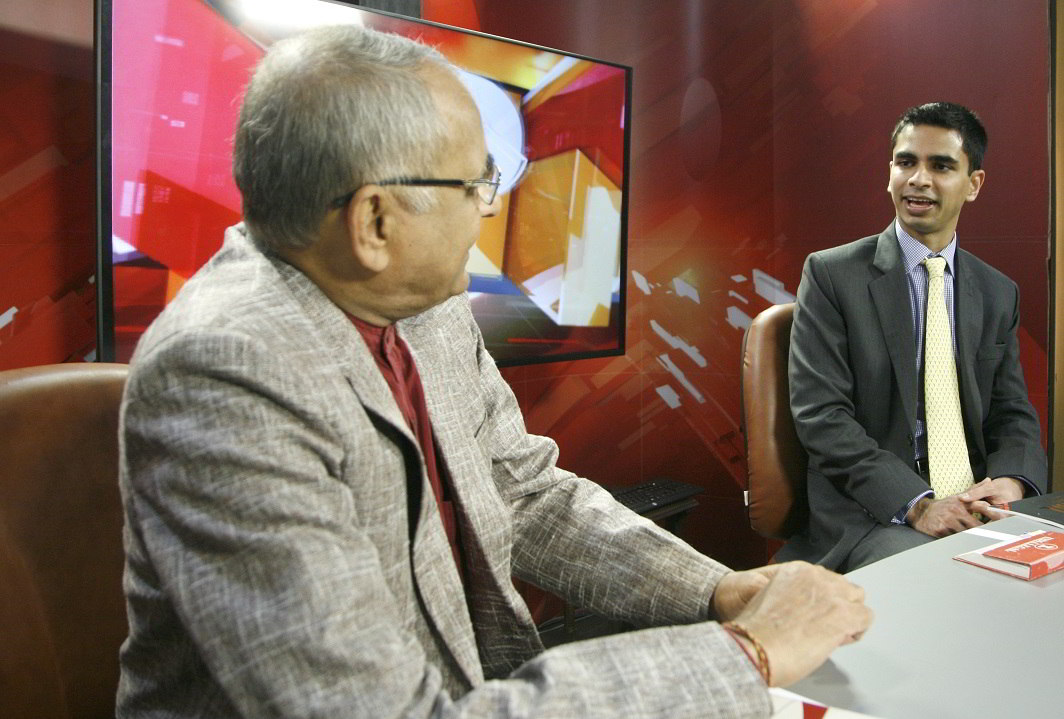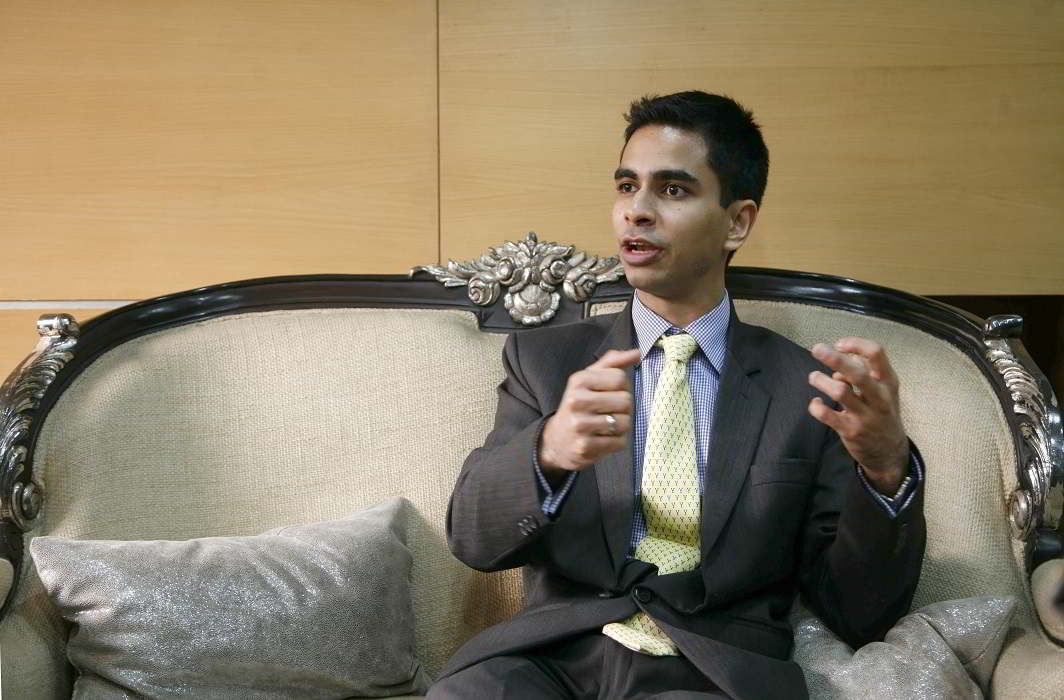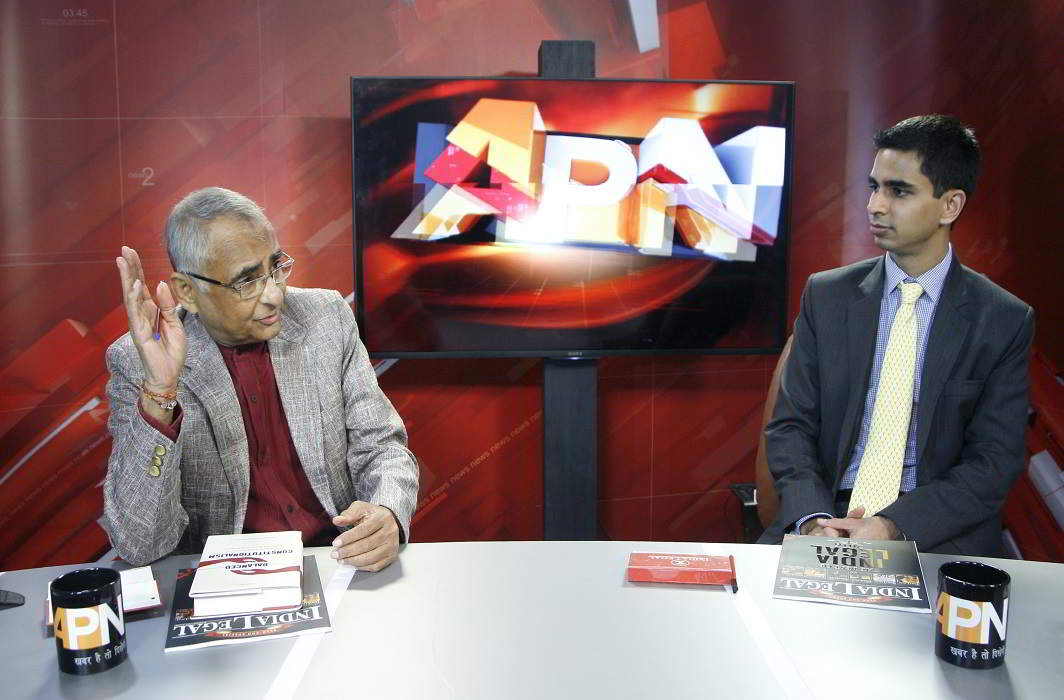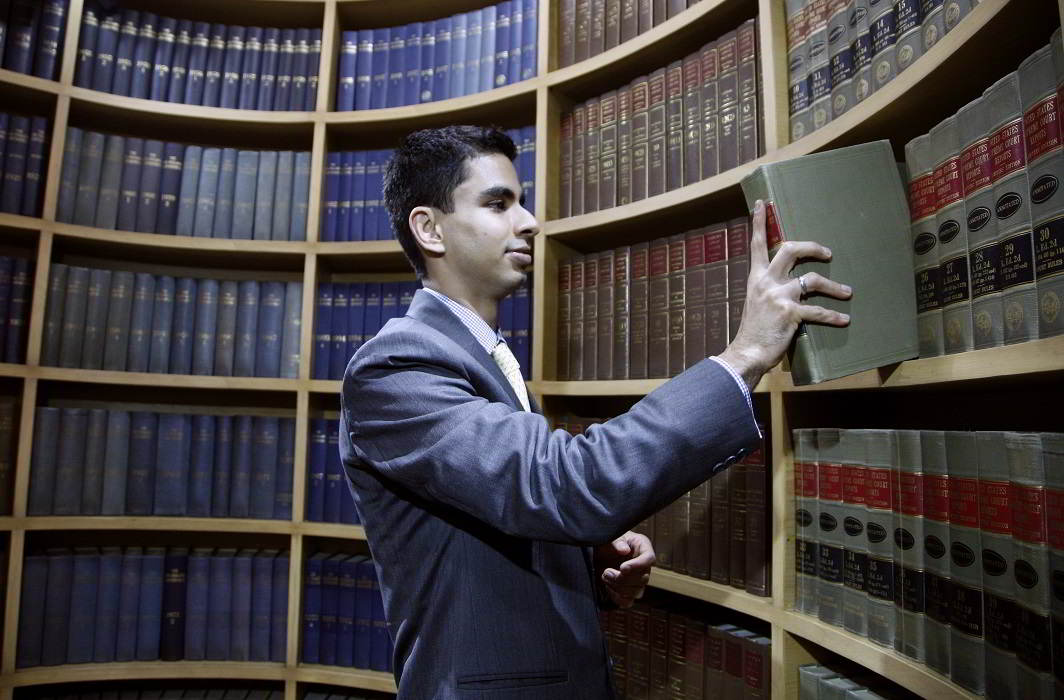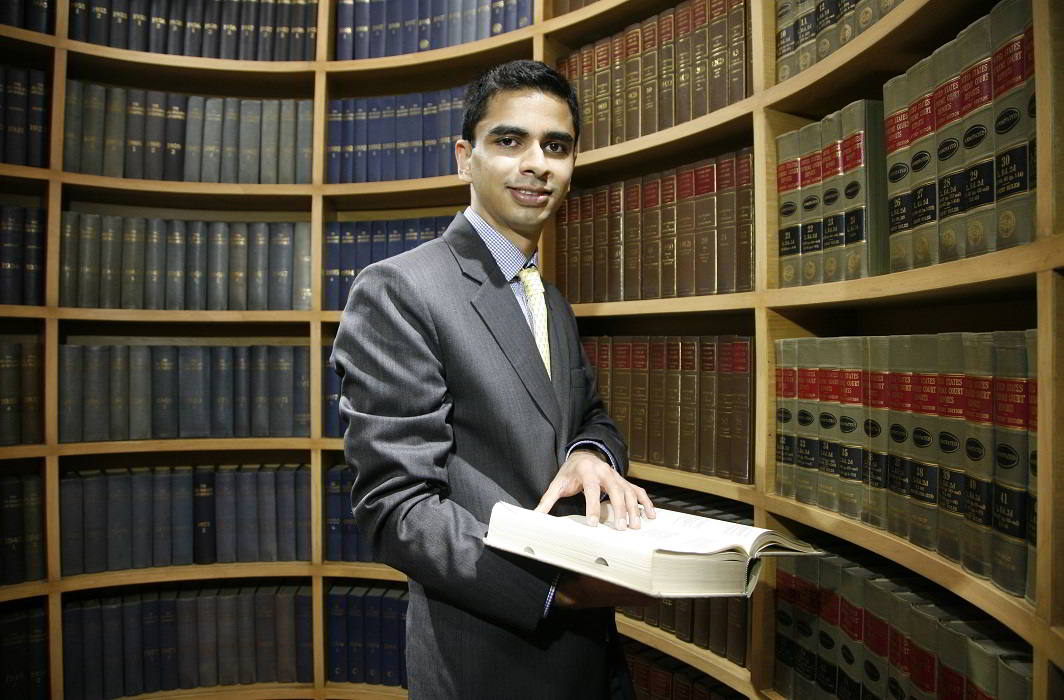Dr Chintan Chandrachud, at an early age, has carved a niche for himself in the field of law. Coming from a renowned lawyer family, Dr Chintan lives in London. An associate at the London office of Quinn Emanuel Urquhart & Sullivan LLP, he also holds a PhD from the University of Cambridge, UK. His research has been published in prominent newspapers, journals and books, and the legal scholar has undertaken several pro bono litigation projects.
The young lawyer’s book: Balanced Constitutionalism – Courts and Legislatures in India and the United Kingdom, was recently released in India and has already become a talking point in legal circles.
Inderjit Badhwar, Editor-in-Chief of India Legal, spoke to him on APN News’ Face to Face programme. Dr Chintan spoke about the subjects covered in his book, and other legal issues impacting India and the West.
Inderjit Badhwar: Looks like you have been bitten by the educational bug. You have a PhD in Law from Cambridge, degrees from Yale and Oxford, and before that, the Bombay Law College. What drove you constantly into academia into this field?
Dr Chintan Chandrachud: The intention after I left Bombay to study at Oxford was to do masters for a year, a programme that they describe as the Bachelors of Civil Law (BCL). A few months into the programme and I realised that I had some serious intellectual appetite which could not really be satisfied.
IB: Insatiable appetite.
CC: An appetite that’s now drawing to an end after I started practicing in London.
IB: Hunger for learning never comes to an end, but now what next?
CC: To start with, there are two things. One is always studying. To say that the learning process ends is incorrect, it takes a different shape. Aside from that, I have started practicing at the London office of Quinn Emanuel Uruquart &Sulolivan, a leading international law firm which is headquartered in Los Angeles. It provides a good marriage of what I have done in the past and what I plan to do in the future.
IB: How much of actual pleading have you done?
IB: Are you a rare species there because Indians the world over, though they are in IT, they are doctors, teachers, also from the law profession. Increasingly, a lot of Indian lawyers though are going from here for arbitration and opening offices there, but what about Indians or people of Indian origin, you don’t find too many of them actually as pleaders and solicitors living and practicing in another country. Are you considered a bit of a rare bird over there?
CC: There’s a burgeoning community of Indian lawyers in London now. Perhaps until a few years ago you wouldn’t see too many Indian lawyers in London, things are changing now. You do have networks of Indian lawyers now, you can actually describe them as a community, it’s a fairly recent development more on the corporate side than on the dispute side, but as legal markets are getting more and more international, there are more of crossovers of Indian lawyers into the UK as a well as UK lawyers into India.
IB: That’s because the platform and the language, thanks to Roman jurisprudence and convention and case law is pretty much the same, because even judgments including some pronounced by your grandfather, and many by your father have references to Canadian precedents, references to European courts increasingly, EU doctrines that are accepted, like human rights documents that are accepted in EU, in the Declaration of Rights, the expansion of Article 21, for example, of the Indian constitution. How much more of this internationalisation do you think will go on, and that will bring me to the subject of your book.
CC: What we notice in recent years is an increasing globalisation of the law, where in a sense there’s almost a fear of remaining in your own silo, and there’s a great attraction associated with looking into how other legal systems or different legal cultures solve problem.
IB: Can you give me an example of any judgment from India that’s been cited in any significant foreign court.
CC: Indian judgments are very commonly currently cited in South Asian foreign courts. You see this all the time. The basic structure doctrine for example is very frequently cited. There’s the Kesavananda Bharati case of course… whether, of course, one is in agreement or disagreement, it’s cited as an authoritative source of law in Bangladesh, Pakistan, Sri Lanka and several other jurisdictions. We need to be slightly cautious of this because there’s always a danger from citing cases from a jurisdiction whose law you agree with.
IB: A lot of this comes full circle. Kesavananda Bharati also drew inspiration from some of the concepts enunciated in the Magna Carta and certainly constitutional debates that took place among the founding fathers of the American constitution. It all seems to have come full circle if Kesavananda Bharati is also being cited in the American context, but the basic spirit of that, of the Kesavananda Bharati pronouncement, its legal soul, what is the link? How is it joined?
CC: In a sense, Kesavananda Bharati provides you with a paradigm example, because on the one hand it did cite several other jurisdictions, case law, legal authorities, it cited philosophy from other jurisdictions. On the other hand, a sea change that you notice after Kesavananda Bharati is that at the time it was decided in 1973, it was thought of as unusual for a constitutional amendment itself to be declared unconstitutional, that was thought of as being a paradox.
IB: That brings me to a question that you have already answered in one of the interviews I saw of yours and I want you to relate this to that, when you were asked about the NJAC decision by the Supreme Court which was a direct confrontation. When you were asked what effect it would have, you had said it was still being played out. Number one, I want you to dwell on that and tell me why you think it’s still being played out that and number two, would you put it in the context of Kesavananda Bharati . Is that still being played out and if not, what would be the lasting impact of Kesavananda Bharati on the Indian political and social atmosphere, because you do see the two being related, don’t you?
CC: Most certainly. What I mean when I say that it’s still being played out is that very often, and this lies at the heart of the book, you only really fully appreciate the significance of a judgment 2-3-4 maybe even more years after the judgment is pronounced. Since the NJAC judgment, there has been uncertainty over what process would be followed. We should be clear about one thing, on the one hand the constitutional amendment was struck down by the court but that did not mean the court said that it’s business as usual , the court did indicate there must be some changes and the existing system of appointments was flawed and problematic. What that means is something that we need to see transpiring over the next year or two. Therefore, to try and fully analyse, we need to wait a while.
Where Kesavananda enters into this picture is quite interesting because on the one hand Kesavananda was viewed as a safety valve. Many people perceived the basic structure doctrine to do was really to protect the state from a 1970s type situation. In other words, a situation where the doctrine wouldn’t be used very frequently, and up to NJAC it hasn’t in fact been used. Many people have argued that the NJAC case is not one of the exceptional cases and wouldn’t really lead to a collapse of democracy, for instance, in India. In many case it’s a reshaping of the Kesavananda doctrine in the NJAC case. One of the reasons is that in the Kesavananda case, focus is on broad over-arching principles. In the NJAC they try and bring those broad over-arching principles down to the ground and try to explain what those principles will mean.
IB: I think you have linked it beautifully. Now apart from the Kesavananda Bharati case, can you cite other cases which you would consider as “seminal” or “progressive”, which helped Indian society move forward? What would be your opinion as a Doctor of Law?
CC: The first judgment that comes to mind as a follow-up of the Kesavananda Bharati case is the Minerva Mills Case. And people do not often understand the significance of the case. What happens after the Kesavananda Bharati case is that the constitution is amended once again. Article 368, which is our amendment clause, is amended to categorically reject the analysis in Kesavananda.
In Minerva Mills, what is crucial about the case is that the Supreme Court’s interpretation of the constitution changes. All the way up to and including Kesavananda, the Court had been interpreting the constitution in a texulous fashion, in other words focusing on the words used in the text, the language of the constitution. In Minerva Mills if they had stuck to the text of the constitution, they would have little choice but essentially to say that Kesavananda was no longer good law. But what happens in that case is the court moves towards a more structuralist interpretation of the constitution, focusing less on the language used and the words used and more really on the institutions of government and the scheme of the constitution itself. I think that is one of the major landmark cases in Indian constitutional law.
I am highly skeptical of some of the recent judgments of the Supreme Court. But one recent example from the Delhi High Court which I would like to cite is the Naz Foundation case and the fantastic judgment given in it by Justice AP Shah wherein the Court reads down Section 377…
CC: Yes, I have mentioned about the case in my book. My major concern about the Naz Foundation and the Supreme Court’s judgment in that case was that it involved an abdication of responsibility by the Supreme Court. The apex court almost seems to suggest that there is a numerical De Minimis associated with the protection of fundamental rights. In other words, if you don’t constitute the right numbers, you are not entitled to protection.
IB: Given the system of appointments, which system do you think leads to a situation in which the judiciary can help along with the legislature—not necessarily as an adversary—to lead you into the so-called ideal of progress?
CC: I think there are problems with each of the three systems of appointments. We are familiar with what the problems with appointments in India often are—lack of merit. It is often perceived that judges who should be in the Supreme Court aren’t there…many of these arguments have been presented in the NJAC case. But, for instance, in the UK, where the appointments systems was relatively recently changed, there are still problems. So, for instance, at the time that the constitutional changes were made in the UK, there was only a single woman Supreme Court, or House of Lords judge, at that time, Baroness Hale. Today more than 10 years later, she continues to be the only woman on the UK Supreme Court. So there are problems really associated with both systems. I think there are larger constitutional frameworks in both systems and this is what I argue about in my book. And this provides for a greater collaboration between courts and legislatures in the UK, rather than in India.
The way I look at it, it is not necessarily a problem for courts and legislatures to become adversaries in some sense, or to assert different interpretations of the constitution, so long as that is within reason and within limits. In UK, you have this interesting nature of the remedy…
IB: What is the remedy?
CC: The British courts do not have the power to strike down primary legislations emanating from the Westminster Parliament. So, in other words, all they can do is to make a declaration of incompatibility which is under Section 4 of the Human Rights Act, indicating that Parliament should change the law and then at least in a formal sense it is up to Parliament to decide whether they wish to change the law or not. Now this produces some interesting effects because what often happens is in situations in which a court even empowered with a stronger power to strike down legislation thinks that power might have serious effects, might have collateral consequences. It is reluctant to use that.
IB: It is probably more difficult to do that in England because it does not have a written constitution… In India at least the constitutional interpretation, or misinterpretation by the judiciary, will have something to lean on in terms of articles…
CC: So now the Human Rights Act has incorporated the European Convention of Human Rights, so the schedule to the human rights contains many of these rights.
IB: That is very important what you brought up. Politically can they, reject the acceptance of European Commission doctrines after Brexit?
CC: One of the immediate fallouts of the Brexit vote or even the Brexit referendum really was less of a focus on the Human Rights Act. Because one of the sticking points leading up to the 2015 general elections was what would happen to the Human Rights Act. The Conservative Party in its manifesto had in fact promised to repeal the Human Rights Act altogether. The Brexit vote, temporarily had shifted the focus away from the Human Rights Act, so it has in some sense given some relief to human rights advocates for the time being. Of course, this is only temporary relief, it is not long-lasting balm. So the situation might turn to the Human Rights Act once we get a clearer picture of what is going to happen with Brexit. As of now, there is of course a great deal of uncertainty about what Brexit means, what the UK’s relationship will be with the EU. But once those issues get ironed out we might come back to this difficult question—about what the fate of the Human Rights Act will be.
So notwithstanding all of my praise for the Human Rights Act, one of the major concerns associated with this model of constitutionalism in general is the fact that such statutes can be repealed by ordinary majority.
IB: In India, the legislature is actually a slavish extension of the executive… the executive privilege is ingrained into the Indian system. In a system like this it is only the judiciary which can keep a check on the runaway executive. Your comments?
CC: My thoughts on judicial activism are quite clear. Actually it depends on what kind of activism we are talking about. If the court on the one hand is making incrementalist judgments which are relatively easily implementable, and which can be enforced on the ground which are in consonance with constitutional principles, then that is an activism which we should welcome, for instance. The problem with the term is it is used quite loosely and so therefore it covers a wide gamut of activities. If we were to compare it to other judgments in which the court very often prescribes guidelines, prescribes legislation, which becomes very difficult to comply with, that tends to denude the institutional authority of the court itself, which is really a very precious commodity. Some of the judgments, which have in fact often been praised, I criticise in my book. And a good example of this may be Vishakha vs State of Rajasthan judgment in which the court prescribes guidelines for sexual harassment in the workplace. Now undoubtedly the intention is noble and no one can question that. The court had good thoughts in mind at that time. For over 13-14 years, the judgment was not complied with. The Supreme Court itself, public authorities, institutions, did not set up grievance redressal committees in accordance with the court’s judgment. This is simply because the court lacks the equipment, the infrastructure that the parliament possesses. The failure to observe the court’s judgments, in my view, seriously erodes its authority.
IB: Ah, excellent point. This is what we were talking about before. I am glad you kind of steered me into this direction because that was going to be my next question. Your very illuminating answer leads me to the next one, which is precisely why when there are judgments that are seemingly set in concrete like the SR Bommai case, which has to do with centre-state relations and in which, just one example, in which it is absolutely crystal clear that the acid test before a governor can dismiss a duly elected government, a floor test has to be proved in terms of majority. And yet you’ve seen in this year alone in India, in the North East and then Uttarakhand, repeatedly courts, and this is one example only, will continue to take up and reopen cases which have been decided by constitutional benches. Why doesn’t the Supreme Court come down much harder on these judges? For doing this, why is it that we continue to see cases going back to the Supreme Court, to double benches and then again to the constitutional bench. On some matters the courts have ruled very firmly. I think there is something flawed here.
CC: I think there’s certainly much to be said about the structure of our courts at this stage. To start with our Supreme Court is under tremendous pressure and we need to be mindful of that. On the one hand it is an attraction and I think it is necessary in fact for scholars, for academics, for practicing lawyers to criticise the way in which the Supreme Court is functioning, the number of cases it takes up and the authorities that it, well, the number of canonical cases even, that it decides from time to time. So one of the things that I’ve said in my book is that whereas if you compare it to the US or the UK Supreme Court, where it’s relatively straight forward to track important judgments made by the court, it is extremely difficult to keep track of all significant judgments passed by the Supreme Court from day to day. And therefore what tends to happen is that even important judgments, important decisions made by the Indian Supreme Court tend to fall under the radar. And this really covers a large part of the spectrum, whether it’s academics, whether it’s other courts, whether it’s practicing lawyers, sheerly because of the numbers. Now of course, the good news is that we may well know what part of the problem is, the bad news is that we don’t really know what the solution is.
IB: You know but, isn’t this also part of the problem of backlogs. And backlogs, pendency as they call it here, is a huge problem because it’s actually the denial of access to justice. Do you see any light at the end of the tunnel and don’t you see this as a gross injustice to the people of India itself? I mean, where else do you see a problem like this?
CC: This is undoubtedly a serious injustice. I think one of the fundamental problems, in terms of principle, with our system is that we focus, or we emphasise too much on getting it right and not enough on getting it right on time. So for instance, several other jurisdictions now recognise one of their fundamental principles of civil justice to be, that a case must be decided, of course correctly, but must also be decided promptly and at a proportionate cost. This is something that needs to be inculcated. It’s a way of thinking really, that needs to be inculcated into our system from the ground level up. That means making changes really across the board, whether it is in terms of increasing the number of judges, setting time limits on trial, changing the way in which adjournments are granted. Or deciding in which cases you should or should not be allowed an appeal.
IB: Chintan, who would do this though? Who would make this reform? Should it come from the judiciary? Of course, it should come from the people. It’s already there from the people but who do you really see belling the cat?
CC: Unfortunately, the state of affairs that currently exist in our nation is that it has to be a combined effort. I think for instance, for the legislature or the executive to try and attempt to make these reforms wholesale, independently, would be extremely difficult and in fact would be wrong. It must, MUST, be a collaborative exercise between the legislature, the executive and the courts. Now of course this is not easy.
IB: One initiative that I think can certainly come from within the judiciary which would make a difference to disposal of cases and justice, this constant changing of benches, you know, the trouble is that institutional memory is lost. There is a judge who understands the case, understands it beautifully, right? Then suddenly the case is postponed for two weeks or three weeks. Out comes another judge or a double bench. It’s like they’ve never even looked through the files, they don’t know what has happened in the past. And they are beginning afresh and a judge who has been able to see through the various tricks that lawyers play, or where they were trying to mislead or misinterpret the law or even mislead the judge, which I guess is also the function of lawyers. It’s a game that goes on. You will see the judgement change in midstream which then casts unnecessary aspersions on the integrity of the system, on the individuals. How do you see this changing? You know there used to be this “part heard,” they don’t use it now much because a lot of judges who did that, were accused of saying “oh, he has a vested interest in this.” Now they don’t put “part heard.” The lower judiciary, for example, does not give bail where it should. Because they think that it might reflect badly on their ACRs later on. Aren’t these changes that come from within the judiciary itself, without any pressure from the outside?
CC: They can. There are in fact some low hanging fruit which I think we should grab on. One of them may well be, for instance, setting up a specialist judiciary. And again, this is associated with so many of the pressures that are placed on our judges. Our judges are often hearing tax cases, criminal appeals, civil cases, company law cases. The next day they may be hearing a dowry case, for instance. The amount of pressure and the expertise that we demand of them is really unrealistic.
IB: The biggest litigant is the government.
CC: Absolutely. Absolutely, and of course the problem there being that the government is itself afraid that if they don’t appeal, there will be accusations that may be made against them, for instance. So these are really some of the problems.
IB: Okay, I think we have covered a tremendous amount and it’s been inspired by a book. I want to show this to our audience again. And one last question- has your father read this book?
CC: Most certainly he has.
IB: If he hasn’t and if the honourable judge is watching this programme, which I hope he does, I would urge you to read this book by an extremely talented young man. Thank you very much Chintan, really enjoyed having you.
CC: Thank you.
Photos: Anil Shakya



